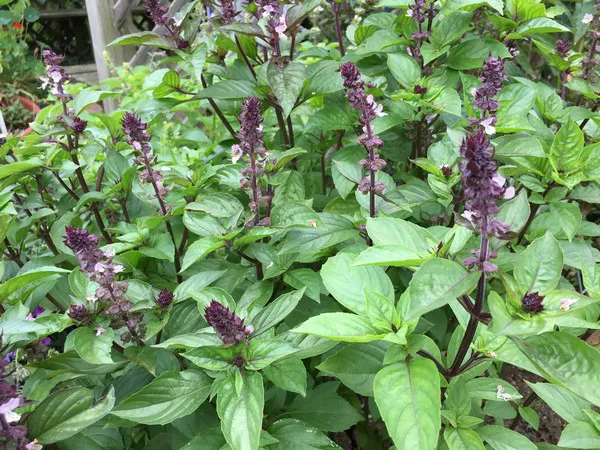Basil (Ocimum basilicum) is one of the most beloved herbs in the culinary world, prized for its aromatic leaves that add a burst of flavor to a variety of dishes. While many people grow basil for its leaves, another valuable part of the basil plant is its flowers, which can be harvested to obtain seeds for future planting. This article provides a comprehensive guide on how to get seeds from basil flowers, ensuring a continual supply of this delightful herb in your garden.
Understanding Basil Flowering
Basil plants typically produce flowers towards the end of their life cycle, usually in the late summer. These flowers are a sign that the plant is focusing its energy on reproduction rather than leaf production. Understanding the flowering process is crucial for seed harvesting.
See Also: Basil Flowers: Edibility, Nutritional Value & Recipes
The Flowering Process
- Initiation of Flowering: Basil plants start flowering when they sense changes in daylight and temperature, often around mid to late summer.
- Flower Structure: Basil flowers are small and white, pink, or purple, growing in clusters on spikes.
- Pollination: These flowers are pollinated by insects, which is essential for seed production.
Why Harvest Basil Seeds?
Harvesting basil seeds has several advantages:
- Cost-Effective: Saving seeds eliminates the need to purchase new ones each year.
- Sustainability: Growing plants from your own seeds supports sustainable gardening practices.
- Preservation of Preferred Traits: If you have a particularly robust or flavorful basil plant, harvesting its seeds allows you to preserve and propagate those desirable traits.
Preparing for Seed Harvesting
To successfully harvest basil seeds, preparation is key. Follow these steps to ensure you’re ready when the time comes:
- Allow the Plant to Flower: Stop pruning the basil plant and let it grow naturally. This encourages flowering and subsequent seed production.
- Monitor Flower Development: Keep an eye on the flowers as they bloom and begin to dry out.
- Choose the Right Plants: Select healthy, vigorous plants for seed harvesting to ensure the quality of future basil plants.
Step-by-Step Guide to Harvesting Basil Seeds
Step 1: Wait for Flower Maturation
- Timing: Basil flowers need time to mature and produce seeds. This can take several weeks after flowering begins.
- Appearance: The flowers will turn brown and dry out. This indicates that the seeds are ready to be harvested.
Step 2: Harvest the Flower Spikes
- Tools Needed: Scissors or pruning shears.
- Method: Carefully cut the flower spikes from the plant. Choose a dry day for harvesting to avoid moisture, which can cause mold during storage.
Step 3: Dry the Flower Spikes
- Drying Method: Place the cut flower spikes in a paper bag or on a drying rack in a well-ventilated area. Ensure they are completely dry before proceeding to the next step.
- Duration: This process can take a few days to a week, depending on humidity levels.
Step 4: Extract the Seeds
- Manual Extraction: Once the flower spikes are dry, gently crumble them over a clean, dry surface. The tiny black seeds will fall out.
- Sieving: Use a fine mesh sieve to separate the seeds from the chaff. This makes it easier to collect and store the seeds.
Step 5: Clean and Store the Seeds
- Cleaning: Remove any remaining plant debris from the seeds.
- Storage: Place the clean seeds in a labeled envelope or a small glass jar. Store them in a cool, dry place away from direct sunlight. Properly stored basil seeds can remain viable for up to five years.
Ensuring Seed Viability
To ensure the seeds you harvest are viable and will germinate successfully, follow these additional tips:
- Avoid Hybrid Plants: Hybrid basil plants may not produce seeds that grow true to the parent plant. Opt for heirloom or open-pollinated varieties.
- Seed Testing: To test seed viability, place a few seeds on a damp paper towel, fold it, and place it in a plastic bag. Keep it in a warm place and check for germination after a week.
Tips for Growing Basil from Seeds
After successfully harvesting basil seeds, knowing how to grow them is equally important. Here are some tips:
- Seed Starting: Start basil seeds indoors 6-8 weeks before the last expected frost date. Use a seed starting mix and provide plenty of light.
- Transplanting: Transplant seedlings outdoors after all danger of frost has passed and the soil has warmed.
- Planting Depth: Sow seeds shallowly, about 1/4 inch deep, and keep the soil consistently moist.
- Spacing: Space basil plants 12-18 inches apart to allow for adequate air circulation and growth.
- Watering: Basil prefers consistent moisture but does not tolerate waterlogged soil. Water the plants regularly, especially during dry periods.
Common Challenges and Solutions
Growing basil from seeds can come with challenges. Here are some common issues and how to address them:
- Poor Germination: Ensure seeds are fresh and viable. Maintain consistent moisture and warm temperatures during germination.
- Damping Off: This fungal disease affects seedlings. Use sterile seed starting mix and provide good air circulation to prevent it.
- Pests: Watch for common pests like aphids and Japanese beetles. Use organic pest control methods if necessary.
Bolting: In hot weather, basil plants can bolt (flower prematurely). Harvest leaves frequently to delay flowering.
Conclusion
Harvesting basil seeds from flowers is a rewarding and sustainable gardening practice. By following the steps outlined in this guide, you can ensure a continual supply of basil in your garden, preserving your favorite varieties and saving money on seeds. Whether you’re a novice gardener or an experienced horticulturist, the process of seed harvesting connects you to the natural lifecycle of your plants and enhances your gardening experience. Enjoy the satisfaction of growing basil from seeds you’ve harvested yourself, and savor the fresh, aromatic leaves in your culinary creations.


